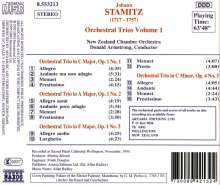Johann Stamitz: Orchestertrios Vol.1 auf CD
Orchestertrios Vol.1
Herkömmliche CD, die mit allen CD-Playern und Computerlaufwerken, aber auch mit den meisten SACD- oder Multiplayern abspielbar ist.
Lassen Sie sich über unseren eCourier benachrichtigen, falls das Produkt bestellt werden kann.
(op. 1 Nr. 1-3; op. 4, 3)
- Künstler:
- New Zealand Chamber Orchestra, Donald Armstrong
- Label:
- Naxos
- Aufnahmejahr ca.:
- 1994
- UPC/EAN:
- 0730099421324
- Erscheinungstermin:
- 13.3.1995
- Serie:
- Naxos 18th Century Classics
Ähnliche Artikel
Alle Orchestertrios scheinen relativ späte Werke zu sein, wahrscheinlich aus der Zeit um 1754-55. Die sechs Orchestertrios op. 1, die 1755 oder Anfang 1756 erschienen, waren die ersten veröffentlichten Werke von Stamitz und erwiesen sich in ganz Europa als sehr einflussreich. In viersätziger Besetzung, wie viele seiner späteren Sinfonien, sind die Trios op. 1 attraktive Werke und in ihrer Konstruktion etwas anspruchsvoller als die Werke vieler seiner Zeitgenossen. Stamitz verzichtet auf einen strengen Kontrapunkt, wie er häufig in der barocken Triosonate zu finden ist, sondern führt häufig kurze, imitierende Passagen zwischen den drei Instrumentalstimmen ein, die die Musik vorantreiben. Langsame Sätze sind einfacher aufgebaut und unterscheiden sich stilistisch nicht von bestimmten Arten von Opernarie dieser Zeit. Die Menuette, kräftig und stark rhythmisch, lassen etwas von der beschwingten Qualität des Wiener Menuetts vermissen, enthalten aber in den Trios oft überraschende harmonische Wendungen, die gelegentlich Spuren osteuropäischer Volksmusik erkennen lassen. Die Finali sind typischerweise leicht und lebhaft und ähneln im Stil häufig der französischen Gigue.
Product Information
All the Orchestral Trios appear to be relatively late works, probably dating from around 1754-55. The six Orchestral Trios Op. 1, which appeared in 1755 or early 1756, were Stamitz's first published works and proved highly influential throughout Europe. Cast in four movements, like many of his later symphonies, the Op. 1 Trios are attractive works and rather more sophisticated in construction than the works of many of his contemporaries. Stamitz eschews strict counterpoint of the kind frequently found in the baroque trio sonata but frequently introduces short imitative passages between the three instrumental parts which serve to propel the music forward. Slow movements are more simply constructed and are not dissimilar in style to certain types of operatic aria of the period. The minuets, sturdy and strongly rhythmical, lack something of the lilting quality of the Viennese minuet but often contain surprising harmonic twists in the Trios, which reveal occasional traces of Eastern European folk-music. The finales are typically light and bustling in character, frequently resembling the French gigue in style.
Disk 1 von 1 (CD)
-
1 Orchestral Trio in C major, Op. 1, No. 1: I. Allegro
-
2 Orchestral Trio in C major, Op. 1, No. 1: II. Andante ma non adagio
-
3 Orchestral Trio In C Major, Op. 1, No. 1: Iii. Menuet
-
4 Orchestral Trio in C major, Op. 1, No. 1: IV. Prestissimo
-
5 Orchestral Trio in A major, Op. 1, No. 2: I. Allegro assai
-
6 Orchestral Trio in A major, Op. 1, No. 2: II. Andante poco adagio
-
7 Orchestral Trio In A Major, Op. 1, No. 2: Iii. Menuet
-
8 Orchestral Trio in A major, Op. 1, No. 2: IV. Prestissimo
-
9 Orchestral Trio in F major, Op. 1, No. 3: I. Allegro molto
-
10 Orchestral Trio in F major, Op. 1, No. 3: II. Larghetto
-
11 Orchestral Trio In F Major, Op. 1, No. 3: Iii. Menuet
-
12 Orchestral Trio in F major, Op. 1, No. 3: IV. Presto
-
13 Orchestral Trio in C minor, Op. 4, No. 3: I. Allegro
-
14 Orchestral Trio in C minor, Op. 4, No. 3: II. Andante
-
15 Orchestral Trio In C Minor, Op. 4, No. 3: Iii. Menuet
-
16 Orchestral Trio in C minor, Op. 4, No. 3: IV. Prestissimo
Mehr von Johann Stamitz
-
Johann StamitzDarmstädter Symphonien D-Dur (D 21), D-Dur (D 23), D-Dur (D 24), G-Dur (G 8), A-Dur, B-Dur (B 4)CDAktueller Preis: EUR 17,99
-
Johann StamitzViolinkonzerte Nr.2-4CDVorheriger Preis EUR 17,99, reduziert um 0%Aktueller Preis: EUR 7,99
-
The Mystery of the Natural TrumpetCDVorheriger Preis EUR 17,99, reduziert um 0%Aktueller Preis: EUR 7,99
-
Concerto Köln - Christmas AlbumCDVorheriger Preis EUR 17,99, reduziert um 0%Aktueller Preis: EUR 9,99








